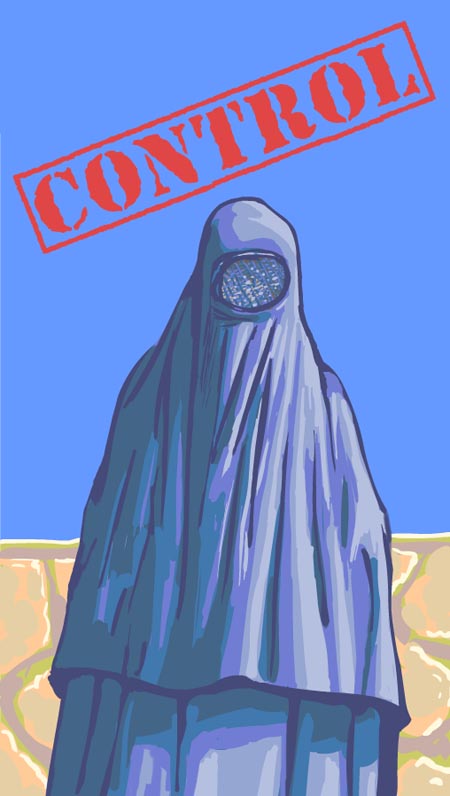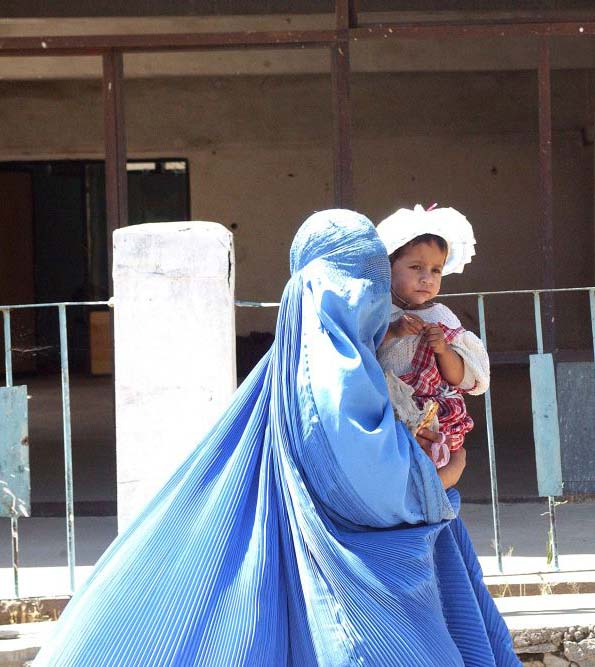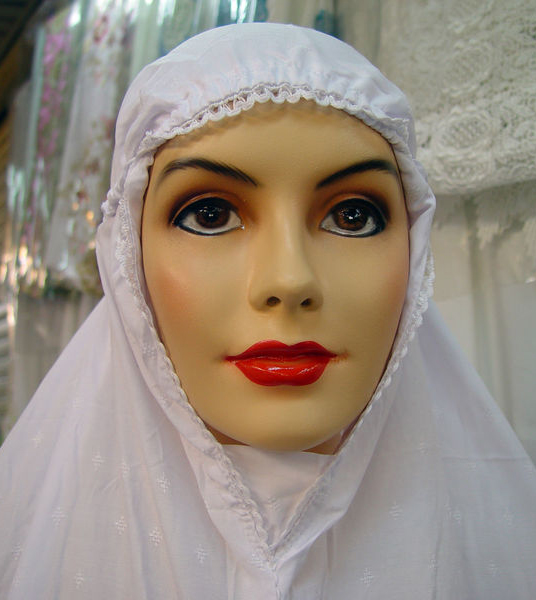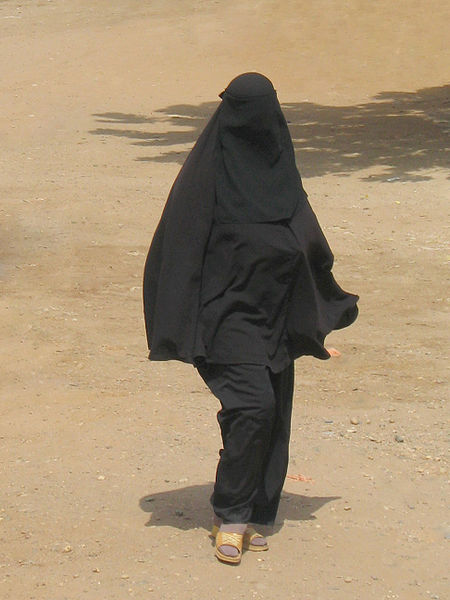|
|||||||||||||
|
Psychoanalysis of its Relationship with Women
The Story of an Ancient By Punkerslut
The Story of Islam's Founding
The founder of Islam, Muhammad, was born in the year 570 or 571, in Mecca. [*1] His father had died six months before he was born, and his mother died when he was only six years old, leaving Muhammad as an orphan. [*2] He was born to the family of Banu Hashim, which was economically doing poorly. [*3] Before having established his religion, Muhammad met Khadija bint Khuwaylid, a prominent trader from a wealthy, merchant family who "had made a fortune in foreign trade." [*4] Through family connections, Muhammad was employed by her at age 25, as an agent for her trading activities. [*5] After gaining her confidence by performing admirably in business, he offered to marry her, and she accepted. The 25-year old profit was now wed to a 40-year old daughter of a wealthy, trading empire. [*6] They remained married together for 25 years, and during this period, Muhammad refused the option having other wives. [*7] [*8] [*9] In 610, only fifteen years after marriage, Muhammad began having visions from Gabriel, who revealed the message of the Qur'an to him over a period of twenty-two years. [*10] [*11] According to the story of Islam's history, Khadija was the first Muslim -- the first person to hear and accept the religion of Allah from Muhammad. [*12] This conversion had an interesting effect on Khadija, who submitted all of her wealth to her husband's plans. According to one Muslim historian, "Khadija told her husband that all her vast wealth was his, and he could spend it just as he wished." [*13] Islam, in its beginnings, was established by a 40-year old man persuading his 55-year old wife to give him her money. [*14] [*15] Muhammad, for the greatness of hearing the message of god, had to beg an old woman so that he could have the right to invest in spreading the message of Allah. The founder of Islam, for all his pride and ego of speaking with the gods, was dependent, like an infant, on the affections of an older woman. The psychoanalysis of Islam and its relationship with women begins here. Muhammad, who had seen god, spoke with the being who created everything. But, at the same, he was reduced to begging for money from a woman who was much older than himself -- he had to get special permission before he was allowed to spend his wife's money in developing this new idea of a religion. Whether she wholeheartedly accepted his plans at first is not entirely certain. It left a strong resentment. Muhammad, born from a poor family and an orphan, had never been important, successful, or powerful; and it was a woman, who was socially ostracized from the entire society and physically his inferior, who he had to ask so he try to become something important. There are two trends established here. First, the use of women as an instrument, an object, and not being valued in themselves. A thousand religions were born every other day in Mecca at that time. Khadija was not encouraged toward any of her own interests and desires, nor was she recognized for anything on her own -- except what she could do for men. Second, there is a jealousy and envy of women, since the founder of Islam was poor and he had to beg a woman for the right to be a missionary. This naturally develops into concepts of fear and hatred. In every way of society, the female partner of Muhammad had excelled her husband, defeating him in receiving prestige, commerce, and wealth. The founder of the religion must have felt terribly inferior and pathetic to be reduced to such a meaningless position by his skills and abilities. To counter such weakness, Muhammad invented a religion with an all-powerful god, who would only communicate with him. These two trends, of women as to be used as objects, and men as inherently inferior to women, were born into Muhammad's religion -- and they thoroughly continued in its development. They mark the essential aspects of any logical psychoanalysis of the religion of Islam.
The Many Wives of Muhammad
When he was 50 years old, Muhammad's wife, Khadija, died. According to much of the histories of Islamic scholars, he was grief-stricken and lonely, and it was only natural that he would marry again. Khawlah bint Hakim, a female companion of Muhammad, had offered to set up the prophet with two, new possibilities: Aisha, a 6-year old girl and cousin of his late wife, or Sawda bint Zama, a 55-year old Muslim widow. Muhammad, in his moment of grief, said, "I want both!" [*16] Aisha had already been "prearranged for marriage," or sold as property, to another suitor, Jubayr ibn Mut'im. But ibn Mut'im was a Muslim and follower of Muhammad, so he put aside his property claims to the 6-year old girl. [*17] There was a 49-year difference between these two wives. After considering the divorce of the aging Sawda bint Zama, she gave up her right to conjugal visits to Aisha. [*18] This is so she would keep her husband -- the glorious, charitable prophet of Allah. These two marriages were the first after Khadija, but they represent the above-noted trend. Muhammad, who now reaching the limits in wealth and influence, chose two wives. First, he chose a woman five years older than him and a widow; finding a husband at this age would have been impossible for her. And second, he chose a six-year girl, who was still at an age of discovering the world around her. In both cases, he chose a situation where he would not stand to be challenged -- those who were weak by their extremes in age. Muhammad lost his first wife, and now had his second and third wives. There would be ten more. [*19] His next wife would be Hafsah bint Umar, who was widowed from one of Muhammad's wars against non-believers. The eighteen year-old girl was turned down by her father's offers to marry her, because Muhammad had spread rumor around camp that he had claimed her. [*20] When the father complained of this is when he felt brazen enough to ask for her marriage. [*21] Zaynab bint Khuzayma was Muhammad's fifth wife. She, too, was a Muslim widowed by the Holy Wars of the Islamic prophet. In fact, there are some Muslim scholars who suggest that Zaynab had lost one husband to Muhammad's wars, Husayn bin al-Harith, as well as her second, Jahsh bin Ri'ab. [*22] Muhammad's marriage proposal entailed approaching her with a bucket containing 12 ounces of gold. [*23] In both of these marriages, to Zaynab and Hafsah, Muhammad had to wait until he felt like he had the upper-hand. In the one case, he prevented everyone from marrying a woman, until her father approached him -- and in the other, he had to approach the woman carrying gold. This is on top of the fact that these women had been married several times and had less of a chance of remarriage than young women. There is an inherent sense of inferiority here, as Muhammad, who communicated with god, could not even talk to a girl, but had to wait for her father to complain about how nobody would marry her. Umm Salama Hind was Muhammad's sixth wife, taken as a widow from one of his fallen soldiers. [*24] Rayhana was Muhammad's seventh wife, but her story is particularly interesting. After overseeing the execution of the men from the Banu Qurayza, Muhammad took on Rayhana as a slave and concubine -- or, more specifically, as a sex slave. It is uncertain whether she actually accepted his proposal of marriage, but either way, it does not seem to be recorded. [*25] Not only was she a neglected widow of the community, but she was also physically Muhammad's property. This cultivated his sense of confidence in thinking that he could propose to her. Zaynab bint Jahsh, the second of Muhammad's wives named Zaynab, was the eighth of Muhammad's wives. She was also Muhammad's blood cousin. [*26] Muhammad first arranged her to marry Zayd, his adopted son, though it is questionable if she rejected this proposal. [*27] [*28] Upon a visit to see his son Zayd, Muhammad accidentally walked in on Zaynab undressing. [*29] [*30] Zayd offered to divorce Muhammad's cousin so that he could have her, and though he initially rejected this, he came around to the idea. That is to say, it was first offered to him, he turned it down, but then he accepted, when Allah visited him and told him that it was his divine duty to take Zaynab as his new wife. [*31] By now, it was a typical excuse he had been using to have access to the former-wives of his followers. Juwayriya bint al-Harith, the ninth of Muhammad's wives, was also the second of them to have first been a sex slave to the early Islamic armies before marriage. Thabit b. Qays b. Al-Shammas, a soldier of Muhammad's, had taken Juwayriya as property at the battle of Banu Mustaliq. But she asked for redemption, and Muhammad -- being begged by a sex-slave of his armies -- found himself confident enough to ask her for marriage. [*32] Her duty and submission to Muhammad were made a condition for the freedom of her people. Or, at least, the ones who had been spared up until that point. Safiyah Bint Huyeiy Ibn Akhtab was Muhammad's tenth wife. The Muslim army invaded Khaibar, slaughtering 17-year old Safiyah's husband and father. She was discovered when Dihya, a soldier of Muhammad, asked "O Allah's Prophet! Give me a slave girl from the captives." Dihya returned with Sayiah, saying to his commander, "O Allah's Apostles! You gave Safiya bint Huyai to Dihya and she is the chief mistress of the tribes of Quraiza and An-Nadir and she befits none but you." [*33] Some were suspicious if Muhammad would actually marry her, saying, "If the Prophet makes her observe the veil, then she will be one of the mothers of the believers, and if he does not make her observe the veil, then she will be his lady slave (sex slave)." But Muhammad did marry her, making it explicitly clear to her that her "mahr" (dowery) for marriage was going to be her freedom -- she had no right to expect wealth in exchange for her subjugation. [*34] Barra bint al-Harith was Muhammad's eleventh wife, but she was the sister-in-law of Abbas, a traditional enemy of the Islamic armies. This marriage was done so that he could make them into allies and enter his home city of Mecca. Her nickname was "Maymuna," meaning blessed, to value his newly established rights of territory. He made it clear that the name had nothing to do with the woman, but with his right to property. [*35] Finally, Maria al Qibtiyya was Muhammad's twelfth wife. She was sent to him as a sex-slave by a Byzantine official. Though she gave him a son, it is unclear whether he actually married her. [*36] There are three particular groups of women that Muhammad prefers. First, women who are either sex slaves or prisoners of war to be sold as slaves. Second, female children. And third, elderly and usually unweddable widows. It is interesting to note that Muhammad's first wife, Khadija, did not fall into any of these categories. More than that, she was wealthy and the source of finance that helped found Islam. And during his marriage to Khadija, Muhammad would have no other wives. This trend was readily abandoned once Muhammad had established his power base of Muslim followers. He did not marry any more rich women, but he did spread out his arms to grab as many wives as possible.
A Testament to Sexism: Fear of Women
Fear and possession. These are the two underlining trends in behavior towards women by Islam. Fear is represented in choosing partners who can be dominated, or in submitting completely to those who cannot. And possession is represented in the use of women as nothing more than the material property of men. The Qur'an, the holy book written by Muhammad, contains much of this same, underlying neurosis. Fear is the dominating aspect of this psychology, and only through this does possession of women appear justified and fair. Muslim women are not allowed to marry non-Muslim men, according to Qur'an 2:221. However, Muslim men are allowed to marry non-Muslim women. The fear is that Muslim women would easily become dominated and controlled by whatever non-Muslim they married, and therefore would give up their religion. Such a view is supported by Muhammad's personal experience with relationships, where he was dominated by Khadija, but dominated the twelve wives after her once he had her wealth. "They question thee (O Muhammad) concerning menstruation. Say: It is an illness, so let women alone at such times and go not in unto them till they are cleansed." (Qur'an 2:222) The natural, bodily functions of a women are "illness," whereas such a description has not been applied to any of the bodily functions of a man. This is a judgment based on fear -- something that happens to women only, and not to men, must clearly be an indication of disease. "...if ye... have had contact with women, and ye find not water, then go to clean, high ground and rub your faces and your hands with some of it." (Qur'an 5:6) The "illness" of menstruation is considered so filthy that rubbing dirt on your body is considered "clean." No such classification exists for the behavior of men, even though the bodily functions of men are not more or less "inherently clean." It is this uncleanness of women that works to separate the value and meaning of the two, different genders. But it is based on ignorance and fear. It is based on the ideas of a man who has always felt inherently weaker to all women -- and therefore, the majority of the Qur'an is about stressing the inherent dirtiness of women. These are not the journal musings of a healthy and curious mind. They are the byproduct of a sense of feeling inferior and weak. Given the severity of the hatred towards women, it is even possible that Muhammad felt himself to be sexually feeble, using the number of his wives as a compensation. None of these ideas are ever directly recognized by Muhammad himself, despite how certain they may be in his typical evaluation of women. But this is an essential attribute of any type of deformed psychology: if Muhammad knew that he hated women because he felt inferior to them, he may not have reacted in such a psychologically unhealthy way, such as declaring women to be inherently dirty. Women are classed among the children and elderly, old men "who are unable to devise a plan..." (Qur'an 4:98) "As for those of your women who are guilty of lewdness... confine them to the houses until death take them or (until) Allah appoint for them a way (through new legislation)." (Qur'an 4:15) "...if ye be ill, or on a journey, or one of you cometh from the closet, or ye have touched women, and ye find not water, then go to high clean soil and rub your faces and your hands (therewith)." (Qur'an 4:43) These all support the underlying theme of women being inherently diseased and unclean -- a judgment that has no fact in science and is based on Gynophobia, or fear of women. This fear of women naturally translates into a will to dominate and control the female gender. It is suggestion as a necessary, counterbalance to the inherently diseased nature of women. Muhammad felt so threatened by the feminine face of humanity that he said, "Men are in charge of women, because Allah hath made the one of them to excel the other, and because they spend of their property (for the support of women)." (Qur'an 4:34) This a sign of a deep neurosis. Muhammad here says that men support women and therefore, have a right to control them. But wasn't it Muhammad, a poor orphan with a poor extended family, that was dependent upon his wealthy wife, even just to get job? The verse continues: "...As for those [women] from whom ye fear rebellion, admonish them and banish them to beds apart, and scourge [beat] them. Then if they obey you, seek not a way against them. Lo! Allah is ever High, Exalted, Great." In the first place, Muhammad justifies his religious domination of women by stating how much women need men -- even though he was a beggar until a woman gave him a job and then all of her wealth. And in the second case, Muhammad reminds us that he is threatened by women; by their "rebellion." It was not defined whether this meant rebellion as in a political revolution or simply acts of disobedience. But either way, the message is clear: Muhammad is paranoid of the abilities that women have over him. His entire life story confirms the outlook he adopted within his religion. "...men are a degree above them (women)." (Qur'an 2:228) Women are only to be valued as half as men when it comes to being witnesses at court proceedings. (Qur'an 2:282) If a woman is accused of adultery, they require four witnesses (Qur'an 24:4), but if a woman is accused by her husband, he requires only one witness. (Qur'an 24:6) "...tell the believing women to lower their gaze and be modest, and to display of their adornment only that which is apparent, and to draw their veils over their bosoms, and not to reveal their adornment..." (Qur'an 24:31) "Tell thy wives and thy daughters and the women of the believers to draw their cloaks close round them (when they go abroad)." (Qur'an 33:59) In its heart, these social regulations are based on limiting and controlling women. The author of these words, who wanted to demean and control women, was dependent on a woman for all of his wealth and fortune. The control of a husband over a wife, or the control of a mob of men over an unveiled woman, all draw back to the same premise: fear. Most modern cultures do not require that women completely cover themselves and live in absolute subjection, almost equivalent to slavery. But that is the interpretation of Islam. What another culture might just see as a daughter, a mother, or a lover in a woman, Islam sees the same woman, and is terrified. "She is a threat to everyone and must be stopped! Not to be trusted as a witness, or to be revealed in public, or to be equal to men in peace and civility!" It is this completely irrational fear that leads to Muhammad's demands of possession (or, slavery)...
A Testament to Sexism: Possession of Women
At first, the ideas of possession of women in the Qur'an were not ideological, as they are today. They were simply personal matters of Muhammad. He went home to his wife one day, telling her that he saw god, and that she had to convert to the new principles of Islam. As the joyous convert of this religion, she provided Muhammad with funds -- "to spread Islam." Slowly, other men became amused with the ideas, knowing that they too could tame by their fear of women by possession of women. God had this message specifically for the women married to Muhammad: "O ye wives of the Prophet! Whosoever of you committeth manifest lewdness, the punishment for her will be doubled, and that is easy for Allah." (Qur'an 33:30) Other instructions to the followers of Muhammad: "...it is not for you to cause annoyance to the messenger of Allah, nor that ye should ever marry his wives after him. Lo! that in Allah's sight would be an enormity." (Qur'an 33:53) The will of god is a difficult matter to unravel, but Muhammad had an interesting idea: it is god's will that I have possession of these women. The Qur'an even contains instructions for dinner parties held by Muhammad: "But if ye are invited, enter, and, when your meal is ended, then disperse. Linger not for conversation. Lo! that would cause annoyance to the Prophet, and he would be shy of (asking) you (to go); but Allah is not shy of the truth." (Qur'an 33:53) Muhammad simply went around and took the things, saying "Lo! It is the will of Allah!" This attitude is clearly manifested in saying that god told him that he was supposed to dominate and control his wife. And beneath that, there is an irrational fear and hatred of women. "Your women are a field for you (to cultivate) so go to your field as ye will..." (Qur'an 2:223) Possessing a woman is like possessing a farm that needs to be cultivated. "Allah chargeth you concerning (the provision for) your children: to the male the equivalent of the portion of two females..." (Qur'an 4:11; Qur'an 4:176) For a moment, there may have been something uplifting there, where Allah commands his people to take care of his children -- but no. "If you take care of your children, make sure men get twice as much as the women." Muhammad had to command this, because he, as a male, had nothing, and his wife, a female, had everything. Deep in his mind, he must sincerely believe that women are trying to run the world, and men must fight back to maintain their lives. If a woman is "flagrantly lewd," (Qur'an 4:19) she may be forcibly taken as a sex slave, given that she has no husband. When deciding to exchange wives, do not take the dowery that came with the woman. (Qur'an 4:20) Sex with married women is prohibited, but sex with slaves is permissible. (Qur'an 4:24) Virgin women were created by Allah for satisfying the needs and pleasures of men. (Qur'an 56:35-38) Those who do not believe in Allah will name their angels with female names. (Qur'an 53:27) This last part is certainly a great offense, to admit that any powerful entity close to Allah could be a woman. The punishment for criticizing your husband is that Allah, god himself, will divorce you and then set your husband up with a better wife. (Qur'an 66:5) This does not sound like a religious text. It sounds like a man in a relationship who feels very insecure about himself and his life. Muhammad should have sought out psychiatric evaluation and help before a professional gave him the okay to found a woman-hating religion.
Resistance to Sexism Means Resistance to Religion
Sexism exists in all religions. In the related religions of Christianity and Judaism, as well as the far-Eastern religions of Hinduism and Shinto. Islam is very peculiar, though. Its domination of women is rooted deeply in fear of women -- and beneath that, a sense of insecurity and lack of confidence in regards to women. These sentiments of Islam naturally have their founding in Muhammad's personal relationships that shaped the Qur'an itself. "You have the right that they should not defile your bed and that they should not behave with open unseemliness. If they do, God allows you to put them in separate rooms and to beat them but not with severity." (Qur'an 4:34) One of the real problems developing is the alarming amount of domestic abuse incidents that result from those who follow the Qur'an's teachings. In Turkey, 40% of women have reported being beaten by their husbands. [*37] In Pakistan, 90% of women reported suffering verbal, sexual, and physical abuse by their husbands. [*38] In Bangladesh, 50% of women with children reported domestic violence from their husbands. [*39] In Egypt, half of married women have reported being physically abused by their partners. [*40] In Iran, 66% of women reported having experienced at least one act of domestic violence during their lifetime. [*41] In one study of Sudanese women, 45% reported being abused by a husband. [*42] All of these nations are Muslim majorities. [*43] [*44] [*45] [*46] [*47] [*48] This alone certainly cannot be the only factor, as one study in the United States showed that nearly 25% of women experienced physical or sexual abuse by a partner at least once. [*49] But, it is certain that Islam facilitates a culture based on one half violently abusing the other. Muhammad felt inferior to women. This is why his chosen marriages have been with women whom he felt that he had complete control over: children, sex-slaves, or old women who had been neglected by society. Overall, Muslim scholars have always attempted to classify these marriages as "humanitarian" or "political." In the first place, they were not humanitarian, but they represented the greatest violation of human rights. And in the second place, they were completely political -- women were not treated as their own beings, worthy of their own identity, but simply as property that may be bought, sold, traded, and destroyed. Punkerslut, Resources *1. "Believers: spiritual leaders of the world," by Elizabeth Goldman, (1995). Oxford University Press. ISBN 0195082400, page 63.
|







